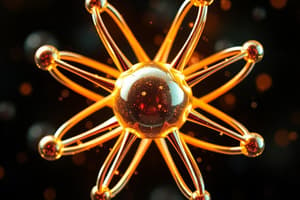Podcast
Questions and Answers
What defines an element and can be used to automatically know the number of protons in an atom of that element?
What defines an element and can be used to automatically know the number of protons in an atom of that element?
- Atomic mass
- Isotopes
- Mass number
- Atomic number (correct)
Which property is not a fundamental property of a given element?
Which property is not a fundamental property of a given element?
- Mass number (correct)
- Atomic number
- Isotopes
- Atomic mass
What must be known to find the mass number of a given atom?
What must be known to find the mass number of a given atom?
- Atomic number
- Number of protons
- Atomic mass
- Number of neutrons (correct)
What is the weighted average of mass numbers of all atoms of an element?
What is the weighted average of mass numbers of all atoms of an element?
What is the atomic number of an atom?
What is the atomic number of an atom?
What is the mass number of a given atom?
What is the mass number of a given atom?
Which subatomic particle has a positive charge and is located in the nucleus of an atom?
Which subatomic particle has a positive charge and is located in the nucleus of an atom?
What is the mass of an electron?
What is the mass of an electron?
Which subatomic particle determines the atomic number of an element?
Which subatomic particle determines the atomic number of an element?
What are atoms with the same atomic number but different mass numbers called?
What are atoms with the same atomic number but different mass numbers called?
Flashcards are hidden until you start studying
Study Notes
- Atoms have subatomic particles called electrons, protons, and neutrons.
- Electrons travel in orbitals outside the nucleus, have no charge and a mass of approximately 1 atomic mass unit (amu).
- Protons are positive charged particles with a mass of 1 amu, reside in the nucleus, and determine the atomic number of an element.
- Neutrons are neutral particles, with a mass of 1 amu, present in the nucleus, and do not influence the atomic number.
- An atom's atomic number can be found on the periodic table and indicates the number of protons in the nucleus.
- The mass number of an atom is the sum of protons and neutrons in its nucleus and determines the total number of nucleons in the nucleus.
- Atoms with the same atomic number but different mass numbers are called isotopes.
- The mass number and atomic number can be represented together as the mass number (superscript) followed by the atomic number (subscript) to the left of the element symbol.
- The number of neutrons in an atom can be calculated by subtracting the atomic number from the mass number.
- The atomic number and mass number provide essential information about an element and its isotopes.
Studying That Suits You
Use AI to generate personalized quizzes and flashcards to suit your learning preferences.




